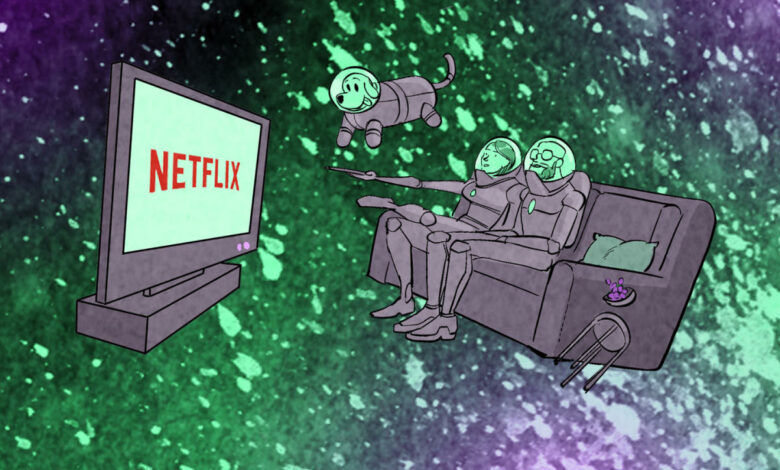Streaming video changed the internet forever

It’s 1995, and I’m trying to watch a video on the internet. I entered the longest, most complex URL I’d ever seen into AOL’s web browser to view a trailer for Paul W.S. Anderson’s long-awaited film adaptation of Mortal Kombat. I found it in an issue of Electronic Gaming Monthly, tucked away in the bottom of a full-page ad for the film. Online marketing at the time was such an afterthought, studios didn’t even bother grabbing short and memorable web addresses for their major releases, let alone dedicated websites. (Star Trek Generations and Stargate were among the few early exceptions.)
After the interminable process of transcribing the URL from print, I gathered my family around our Packard Bell PC (powered by an Intel 486 DX and, let’s say, 8MB of RAM), hit return and waited as the video slowly came down our 33.6kbps dial-up connection. And waited. It took 25 minutes for it to fully load. After corralling my family once again, I hit play and was treated to an horrendously compressed, low-resolution version of the trailer I’d been dreaming about for months. It was unwatchable. The audio was shit. But that was the moment I became obsessed with online video.
I imagined a futuristic world beyond my boxy CRT set and limited cable TV subscription. A time after VHS tapes when I could just type in a URL and enjoy a show or movie while eating one of those rehydrated Pizza Hut pies from Back to the Future 2. The internet would make it so.
Looking back now, almost 30 years later, and 20 years after Engadget sprung to life, I realize my 11-year-old self was spot on. The rise of online video transformed the internet from a place where we’d browse the web, update our LiveJournals, steal music and chat with friends on AIM to a place where we could also just sit back and relax. For Millennials, it quickly made our computer screens more important than our TVs. What I didn’t expect, though, was that streaming video would also completely upend Hollywood and the entire entertainment industry.
If my experience with the Mortal Kombat trailer didn’t make it clear enough, video was a disaster on the internet in the ’90s. Most web surfers (as we were known as the time) were stuck with terribly slow modems and similarly unimpressive desktop systems. But really, the problem goes back to dealing with video on computers.
Apple’s Quicktime format made Macs the ideal platform for multimedia creators, and, together with its Hypercard software for creating interactive multimedia databases, it spawned the rise of Myst and the obsession with mixed-media educational software. PCs relied on MPEG-1, which debuted in 1993 and was mainly for VCDs and some digital TV providers. The problem with both formats was space: Hard drives were notoriously small and expensive at the time, which made CDs the main option for accessing any sort of video on your computer. If your computer only had a 500MB hard drive, a slim disc that could store 650MB seemed like magic.
But that also meant video had no place in the early internet. RealPlayer was the first true stab at delivering streaming video and audio online — and while it was better than waiting 20 minutes for a huge file to download, it was still hard to actually stream media when you were constrained by a dial-up modem. I remember seeing buffering alerts more than I did any actual RealPlayer content. It took the proliferation of broadband internet access and one special app from Adobe to make web video truly viable.
While we may curse its name today, it’s worth remembering how vital Macromedia Flash was to the web in the early 2000s. (We’ve been around long enough to cover Adobe’s acquisition of Macromedia in 2005!) Its support for vector graphics, stylized text and simple games injected new life into the internet, and it allowed just about anyone to create that content. HTML just wasn’t enough. Ask any teen or 20-something who was online at the time, and they could probably still recite most of The End of the World by heart.
https://www.youtube.com/watch?v=kCpjgl2baLs
With 2002’s Flash MX 6, Macromedia added support for Sorenson’s Spark video codec, which opened the floodgates for online video. (It was eventually replaced in 2005 by the VP6 codec from On2, a company Google acquired in 2009.) Macromedia’s video offering looked decent, loaded quickly and was supported on every browser that had the Flash plugin, making it the ideal player choice for video websites.
The adult entertainment industry latched onto Flash video first, as you’d expect. Porn sites also relied on the technology to lock down purchased videos and entice viewers to other sites with interactive ads. But it was YouTube (and, to a lesser extent, Vimeo) that truly showed mainstream users what was possible with video on the internet. After launching in February 2005, YouTube grew so quickly it was serving 100 million videos a day by July 2006, making up 60 percent of all online videos at the time. It’s no wonder Google rushed to acquire the company for $1.65 billion later that year (arguably the search giant’s smartest purchase ever).
After YouTube’s shockingly fast rise, it wasn’t too surprising to see Netflix announce its own Watch Now streaming service in 2007, which also relied on Flash for video. At $17.99 a month for 18 hours of video, with a library of only 1,000 titles, Netflix’s streaming offering didn’t seem like much of a threat to Blockbuster, premium cable channels or cinemas at first. But the company wisely expanded Watch Now to all Netflix subscribers in 2008 and removed any viewing cap: The Netflix binge was born.
It’s 2007, and I’m trying to watch a video on the internet. In my post-college apartment, I hooked up my desktop computer to an early-era (720p) Philips HDTV, and all of a sudden, I had access to thousands of movies, instantly viewable over a semi-decent cable connection. I didn’t need to worry about seeding torrents or compiling Usenet files (things I’d only heard about from dirty pirates, you see). I didn’t have to stress about any Blockbuster late fees. The movies were just sitting on my TV, waiting for me to watch them. It was the dream for digital media fanatics: Legal content available at the touch of a button. What a concept!
Little did I know then that the Watch Now concept would basically take over the world. Netflix initially wanted to create hardware to make the service more easily accessible, but it ended up spinning off that idea, and Roku was born. The company’s streaming push also spurred on the creation of Hulu, announced in late 2007 as a joint offering between NBCUniversal and News Corp. to bring their television shows online. Disney later joined, giving Hulu the full power of all the major broadcast TV networks. Instead of a stale library of older films, Hulu allowed you to watch new shows on the internet the day after they aired. Again, what a concept!
Amazon, it turns out, was actually earlier to the streaming party than Netflix. It launched the Amazon Unbox service in 2006, which was notable for letting you watch videos as they were being downloaded onto your computer. It was rebadged to Amazon Video On Demand in 2008 (a better name, which actually described what it did), and then it became Amazon Instant Video in 2011, when it was tied together with premium Prime memberships.
As the world of streaming video exploded, Flash’s reputation kept getting worse. By the mid-2000s, it was widely recognized as a notoriously buggy program, one so insecure it could lead to malware infecting your PC. (I worked in IT at the time, and the vast majority of issues I encountered on Windows PCs stemmed entirely from Flash.) When the iPhone launched without support for Flash in 2007, it was clear the end was near. YouTube and other video sites moved over to HTML5 video players at that point, and it became the standard by 2015.
By the early 2010s, YouTube and Amazon weren’t happy just licensing content from Hollywood, they wanted some of the action themselves. So the original programming boom began, which kicked off with mostly forgettable shows (anyone remember Netflix’s Lillyhammer or Amazon’s Alpha House? Hemlock Grove? They existed, I swear!).
But then came House of Cards in 2013, Netflix’s original series created by playwright Beau Willimon, executive produced (and partially directed) by renowned filmmaker David Fincher and starring Oscar winner Kevin Spacey (before he was revealed to be a monster). It had all of the ingredients of a premium TV show, and, thanks to Fincher’s deft direction, it looked like something that would be right at home on HBO. Most importantly for Netflix, it got some serious awards love, earning nine Emmy nominations in 2013 and walking away with three statues.
By that point, we could watch streaming video in many more places than our computer’s web browser. You could pull up just about anything on your phone and stream it over 4G LTE, or use your smart TV’s built-in apps to catch up on SNL over Hulu. Your Xbox could also serve as the centerpiece of your home entertainment system. And if you wanted the best possible streaming experience, you could pick up an Apple TV or Roku box. You could start a show on your phone while sitting on the can, then seamlessly continue it when you made your way back to your TV. This was certainly some sort of milestone for humanity, though I’m torn on it actually being a net win for our species.
Instant streaming video. Original TV shows and movies. This was the basic formula that pushed far too many companies to offer their own streaming solutions over the past decade. In the blink of an eye, we got HBO Max, Disney+, Apple TV+, Peacock, and Paramount+. There’s AMC+, powered almost entirely by the promise of unlimited Walking Dead shows. A Starz streaming service. And there are countless other companies trying to be a Netflix for specific niches, like Shudder for horror, Criterion Channel for cinephiles and Britbox for the tea-soaked murder-mystery crowd.
And let’s not forget the wildest, most boneheaded streaming swing: Quibi. That was Dreamworks mastermind Jeffrey Katzenberg’s nearly $2 billion mobile video play. Somehow he and his compatriots thought people would pay $5 a month for the privilege of watching videos on their phones, even though YouTube was freely available.
Every entertainment company thinks it can be as successful as Disney, which has a vast and beloved catalog of content as well as full control of Lucasfilm and Marvel’s properties. But, realistically, there aren’t enough eyeballs and willing consumers for every streaming service to succeed. Some will die off entirely, while others will bring their content to Netflix and more popular services (like Paramount is doing with Star Trek Prodigy). There are already early rumors of Comcast (NBCUniversal’s parent company) and Paramount considering some sort of union between Peacock and Paramount+.
Online video was supposed to save us from the tyranny of expensive and chaotic cable bills, and despite the messiness of the arena today, that’s still mostly true. Sure, if you actually wanted to subscribe to most of the major streaming services, you’d still end up paying a hefty chunk of change. But hey, at least you can cancel at will, and you can still choose precisely what you’re paying for. Cable would never.
It’s 2024, and I’m trying to watch a video on the internet. I slip on the Apple Vision Pro, a device that looks like it could have been a prop for The Matrix. I launch Safari in a 150-inch window floating above my living room and watch the Mortal Kombat trailer on YouTube. That whole process takes 10 seconds. I never had the chance to see the trailer or the original film in the theater. But thanks to the internet (and Apple’s crazy expensive headset), I can replicate that experience.
Perhaps that’s why, no matter how convoluted and expensive streaming video services become, I’ll always think: At least it’s better than watching this thing over dial-up.
To celebrate Engadget’s 20th anniversary, we’re taking a look back at the products and services that have changed the industry since March 2, 2004.
Source link




